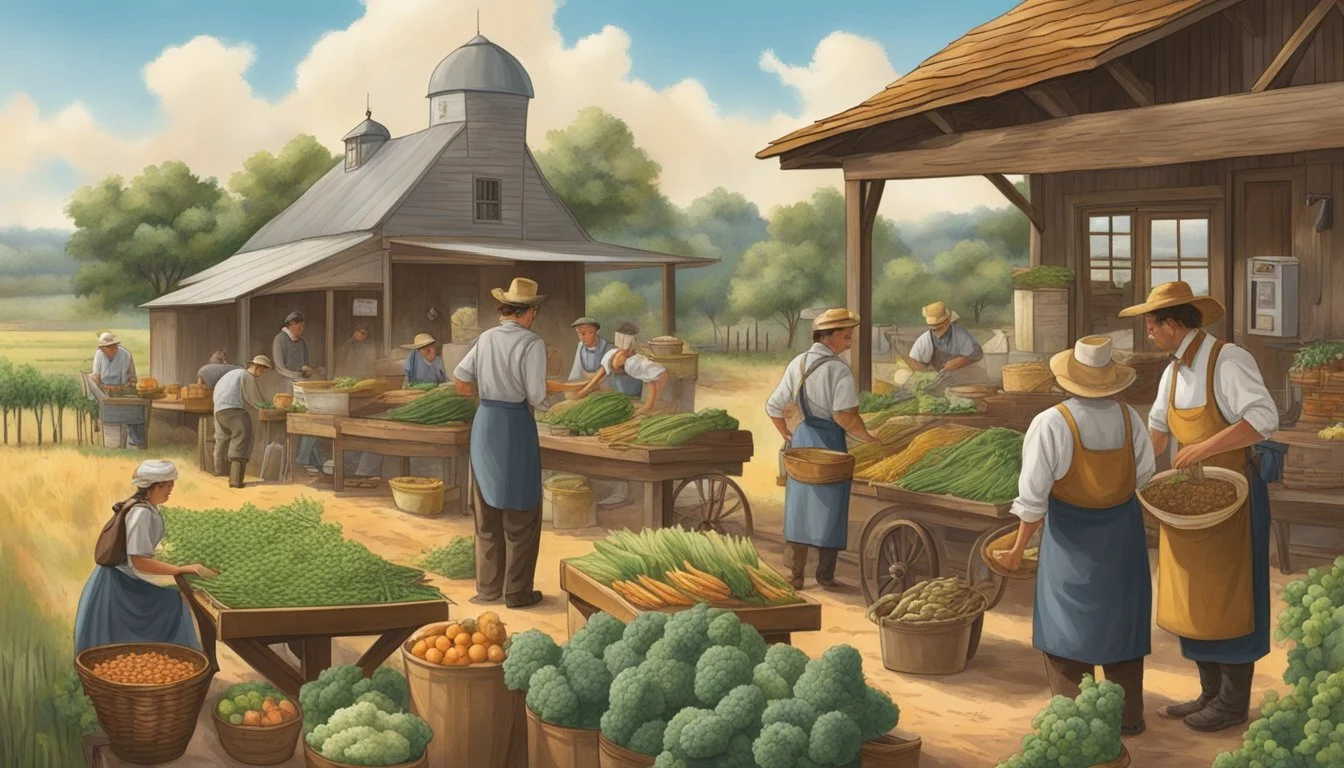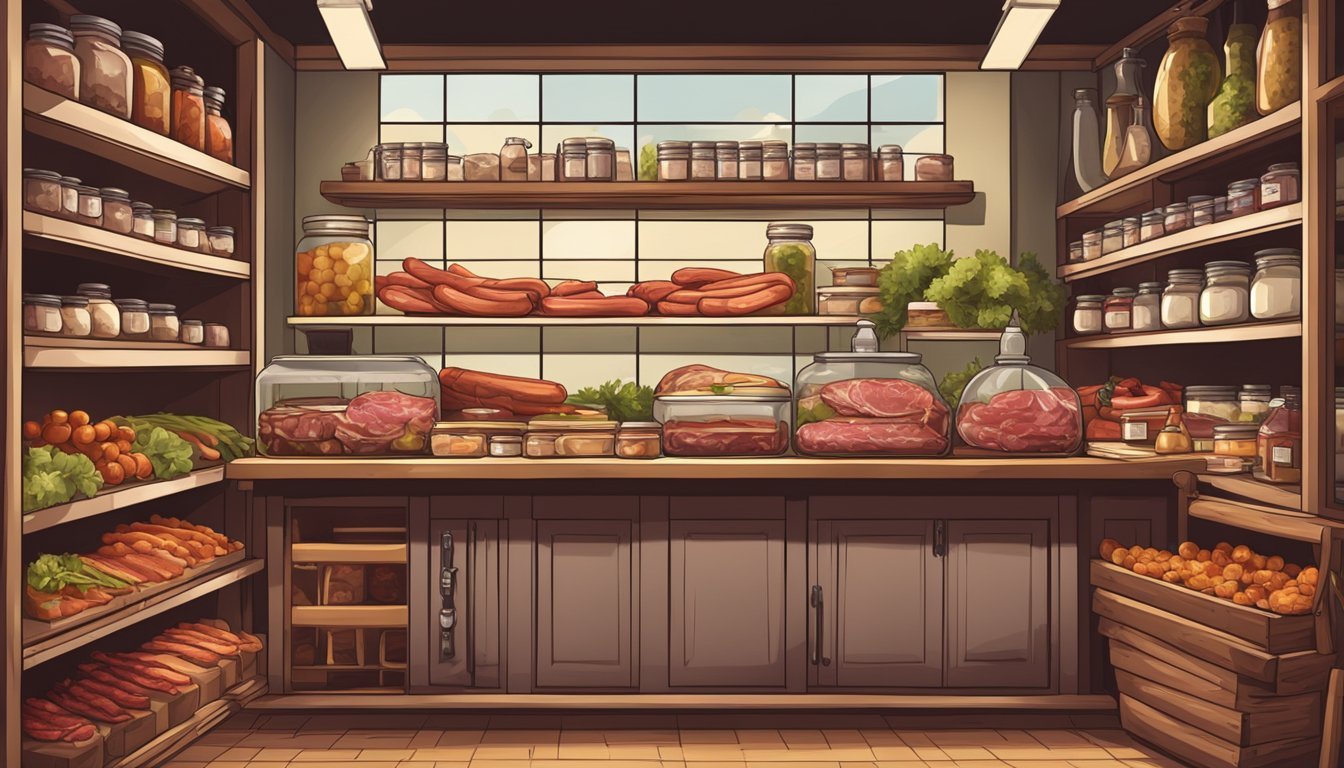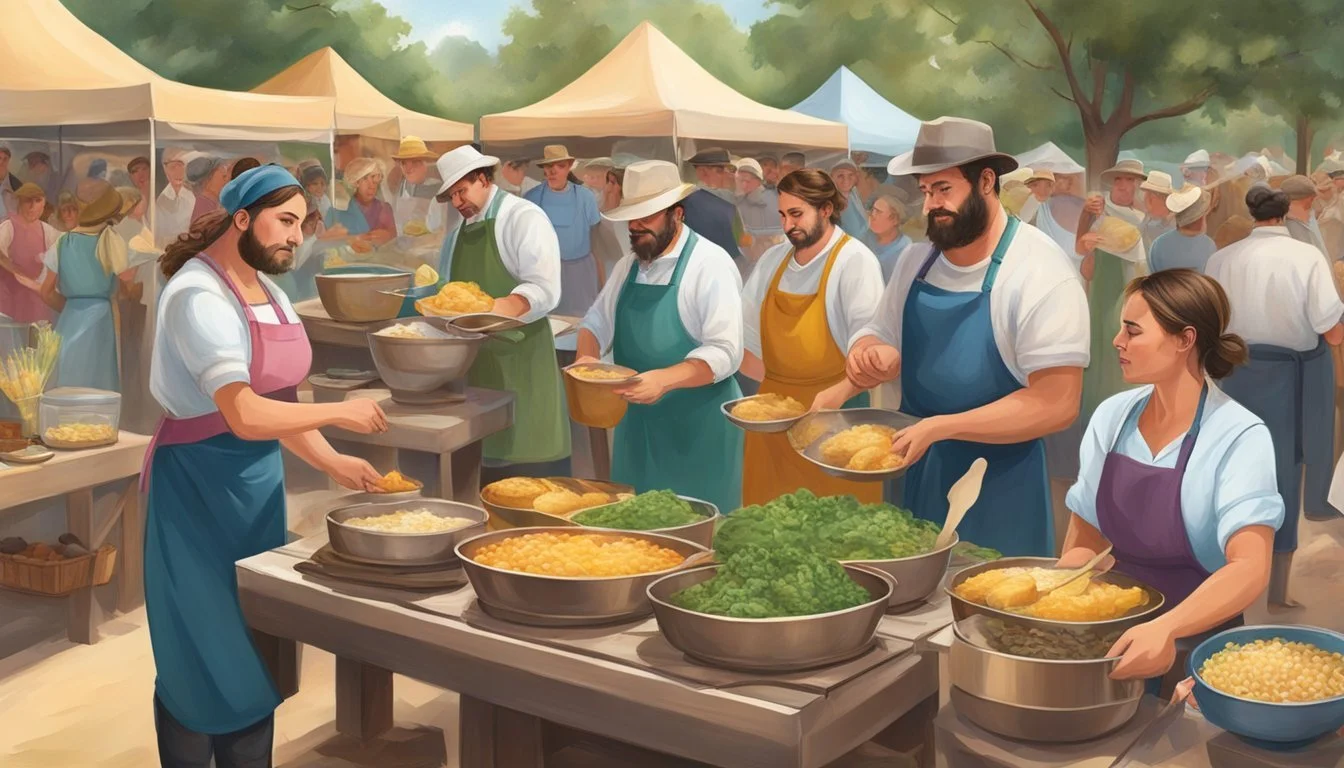The Influence of German Immigrants on Texas Artisanal Food Production
A Culinary Legacy Unveiled
The culinary landscape of Texas offers a vivid tapestry of flavors and traditions, part of which owes its heritage to German immigrants. In the mid-19th century, German settlers began to arrive in Texas in significant numbers, bringing with them their rich gastronomic practices. These immigrants played a pivotal role in shaping the state's artisanal food production, introducing techniques and recipes that have been preserved and adapted over the generations. In towns such as Fredericksburg and New Braunfels, one can observe the enduring legacy of German craftsmanship in the production of bread, beer, and particularly meats such as sausage—an integral part of Texan cuisine.
As these communities established themselves, the influence of German culinary traditions became interwoven with local ingredients and methods. Artisanal food production blossomed as German Texans sourced local meats and produce to create products reminiscent of their homeland yet distinctively Texan. This culinary melding led to the establishment of long-standing festivals like Wurstfest, which celebrate and showcase these hybrid food traditions. German-Texan artisans have thus contributed not only to the variety and richness of Texas's food culture but have also fostered a sense of historical continuity and cultural identity.
Historical Context of German Immigration to Texas
The wave of German immigrants to Texas began in the early 19th century and played a crucial role in the state's development. Their influence was particularly notable in the area of artisanal food production.
Early Settlements and Land Grants
Johann Friedrich Ernst is often credited as the forefather of German settlements in Texas. He received a land grant in 1831, establishing his homestead in present-day Austin County. This initial settlement acted as a beacon for future German migrants. The land grant system was instrumental in encouraging Germans to leave their homeland in pursuit of better living conditions and economic opportunity. These early German settlers quickly adapted to the Texas landscape, employing their agricultural and artisanal skills.
Chain Migration Growth
The concept of chain migration played a pivotal role in expanding the German presence in Texas. As early settlers like Ernst sent positive reports back to Germany, they encouraged family and friends to join them. This phenomenon increased the number of German immigrants dramatically. Cities such as New York and New Orleans served as primary entry points into the United States for these migrants before they made their way to Texas. Chain migration ensured a steady influx of German knowledge and customs, including those pertaining to food production.
German Impact on Texas during the 19th Century
During the 19th century, German migrants significantly shaped Texan culture and its culinary landscape. German nobles, seeking to invest in the New World, supported immigration efforts, which in turn led to the establishment of towns like New Braunfels and Fredericksburg—communities that became hubs for German tradition. German immigrants introduced practices such as fishing and farming techniques essential for local food production. By the end of the century, Germans made up over five percent of the Texas population, embedding their artisanal skills into the fabric of Texan society.
Cultural Integration and Influence
The melding of German and Texan artisanal food traditions has generated a distinctive culinary ethos in Texas, characterized by a deep respect for craftsmanship and a fusion of flavors, reflecting the state's diverse cultural heritage.
Fusion of German and Texan Cultures
The symbiosis of German and Texan culinary practices resulted in an enriched food culture that bears the hallmarks of both traditions. German immigrants, with their rich gourmet heritage, brought to Texas the techniques of smoking and curing meats, pivotal in the evolution of the renowned Texas barbecue. These methods, merged with Texan ranching culture, led to a unique style of barbecue that spotlights the flavors imparted by the Texan woods and the meticulous German approach to meat preparation.
Family-run enterprises often serve as custodians of this blended gastronomic legacy, ensuring that the methods and recipes passed down through generations remain an integral aspect of Texas's culinary identity. Meanwhile, the Texas environment, rich in resources and ingredients, has by reciprocity influenced German recipes, integrating local spices and methods that exhibit a Texas twist on traditional German foods.
Preservation of German Traditions and Cuisine
Despite the fusion with Texan culinary traditions, many German customs and dishes maintain their integrity and continue to be celebrated in the Texas food scene. Annual festivals such as Wurstfest in New Braunfels, honor German culture, and cuisine, attracting thousands of visitors who come to indulge in traditional German foods like sausages and beer.
German foods: Sausages, breads, and pastries remain staples within Texan communities, often reflecting the skills and recipes of German and Czech immigrants.
Czech influence: Apart from German influences, Texas's culinary heritage also encompasses Czech contributions, particularly in the realm of bakery, with items like kolaches becoming beloved snacks across the state.
Local businesses often focus on the production of artisanal goods that draw from German traditions. Ingredients like beef and pork are prepared with cultural heritage in mind, resulting in products that speak to both the traditional German emphasis on quality and the robust character of Texan tastes. Through this persistence of cultural practices, German cuisine (What Wine Pairs Perfectly With German Cuisine) has not only been preserved but has also thrived, becoming an indispensable part of the diverse tapestry of cultures in Texas.
German Artisanal Foods and Recipes
The German influence on Texas's artisanal food landscape is particularly evident in the state's meat production, baked goods, and beer brewing. These traditions brought over by German immigrants have been preserved and integrated into Texan cuisine, enhancing the state’s culinary diversity.
Influence on Texas Barbecue and Meat Production
Sausages have become a staple in the Texan barbecue scene, with German techniques deeply influencing local meat processing. Varieties of pork and beef sausages, often seasoned with spices like garlic, salt, and paprika, reflect this heritage. Smoked meats, a common element in Texan barbecue, owe much to the German approach to smoking, which imparts a distinctive flavor and preserves the meat.
Fredericksburg and New Braunfels Markets:
Pork and beef sausages
Veal specialties
Artisanal meat products adhering to traditional recipes
The process often involves curing meats with a combination of salt and spices, followed by a slow smoking over wood. This method not only flavors the meat but also preserves it, a necessity in the days before refrigeration.
German Baked Goods and Pastries
Baked goods and pastries are another significant contribution of Germans to Texan food culture. Pastries such as strudel, rich with fillings like sweetened fruits or savory meats, and various breads enriched with milk and butter are common. Breakfast and lunch menus in Texas often feature items like:
Soft pretzels with mustard
Sweet pastries for breakfast
Hearty breads incorporating whole grains
These baked goods often feature distinctive flavors of spices and a dedication to the craft of baking, showcasing a range of products from simple farmer's bread to elaborate strudels.
Beer and Brewing Traditions
German settlers brought with them a rich beer-brewing tradition, which has left a lasting mark on the Texan beverage scene. Beer is a vital component of German-Texan culinary practices, celebrated in festivals and served across the state. Key elements of this tradition include:
Use of specific yeast strains
Purity of ingredients, often adhering to the Reinheitsgebot, the German Beer Purity Law of 1516
A variety of beer styles, from lagers to ales
The legacy is especially prominent in towns like Fredericksburg, where German heritage is strong, and local breweries continue to produce beer using traditional methods — a testament to the enduring appeal of German brewers' meticulous craft.
Social and Economic Contributions
German immigrants have markedly influenced Texas’s artisanal food production, particularly in establishing prominent wineries, breweries, and family-run food businesses. These contributions have been most pronounced in regions such as Central Texas, with cities like Austin, San Antonio, and Dallas experiencing the integration of German culinary heritage into local markets and dining establishments.
Establishment of Texas Wineries and Breweries
German settlers were instrumental in establishing the wine industry in Texas. Central Texas quickly became a hub for vineyard development, utilizing German viticulture techniques. These pioneers laid the groundwork for the thriving wineries found across the state today. Similarly, breweries also owe a debt to German traditions. The Spoetzl Brewery, known for its acclaimed Shiner beers, exemplifies the success of German influence. It upholds the heritage of quality and craftsmanship that began with earlier German Texans, even becoming a cultural mainstay celebrated at events like Oktoberfest.
Immigrant Families in Food Business and Restaurants
The footprint of German immigrant families is readily apparent in the food business and restaurants across Texas. Numerous family-owned restaurants and butcher shops opened by German families continue to operate, maintaining traditional approaches to food preparation. For instance, central Texas is home to restaurants and markets in cities such as Austin and San Antonio, where German culinary influence is still prevalent. Dallas also hosts a variety of dining establishments that trace their roots back to these German settlers. These businesses contribute to regional economies, with family-owned entities being particularly well-regarded for their commitment to authenticity and quality.
Modern Legacy and Festivals
German immigrants have profoundly impacted Texas's local food scene, leaving a legacy that thrives in modern festivals and everyday dining experiences. These traditions celebrate the cultural fusion that persists in culinary techniques, recipes, and community gatherings.
Oktoberfest and German Festivals in Texas
Texas boasts numerous festivals that celebrate its German heritage, with Oktoberfest being among the most iconic. These events are key venues for experiencing traditional German food and music, and they preserve the communal spirit brought by European settlers.
Fredericksburg: A town known for preserving its German roots, it hosts an annual Oktoberfest that features German bands and authentic dishes like schnitzel and bratwurst.
New Braunfels: This city's Wurstfest is a 10-day event highlighting German culture, packed with music performances and a variety of foods, from classic Texas barbecue to German staples.
The festivals are also showcases for traditional craftsmanship, with woodworking and grilling techniques on display - all honoring methods introduced by German Texans.
Continued Influence on Dining and Culinary Tradition
German influence on Texas's dining and culinary tradition persists notably in artisanal food production:
Bakeries: They offer an array of bread and pastries, using recipes passed down from German Texans.
Breweries: Local craft beers have a direct lineage to the breweries established by the Germans in Texas, with towns like Boerne and New Braunfels being particularly notable.
Dining: Restaurants throughout the Hill Country offer menus that integrate German culinary traditions, such as sauerkraut and sausages, often incorporating local ingredients and wood-smoked flavors.
Areas like Fredericksburg also boast wineries that reflect the German penchant for winemaking, with many citizens of German descent playing a vital role in these enterprises. This fusion extends beyond single dishes to encompass the overall approach to food—a blend of German precision and Texas flair.
Locations Influenced by German Heritage
German immigrants have made a significant impact on certain areas in Texas, particularly in Central Texas, where numerous towns and neighborhoods reflect German heritage through their artisanal food production, landmarks, and architecture.
German-Texan Towns and Neighborhoods
In Central Texas, Fredericksburg stands out as a prime example of German influence; this town maintains strong ties to its heritage, with German traditions obvious in its local cuisine and community events. New Braunfels also boasts a rich German history, observable in its food festivals celebrating traditional German fare, such as the ubiquitous hot dog topped with onions. Similarly, Pflugerville and Boerne are notable for their populations of German descent, with local businesses often producing artisanal foods that pay homage to their German roots.
Landmarks and Architecture
German influence extends beyond just food and festivals; it is embedded in the very land and architecture of certain Texan areas. Fredericksburg's architectural landscape is dotted with historic homes built in traditional German styles, while New Braunfels showcases distinctive structures that reflect the German ethos of its original settlers. Both towns serve as landmarks in their own right, attracting visitors keen to experience Texas's German heritage firsthand. The layout of these towns often follows the original plans of their German immigrant founders, contributing to the rich cultural tapestry of the region.
Current Trends and the Future of German-Texan Cuisine
The integration of German culinary tradition with Texan flavors has created a dynamic artisanal food culture set to evolve in innovative ways. This section delves into the resurgence of heritage foods and the enduring impact of German-Texan cuisine on the lifestyle of the region.
Renaissance of Artisanal Food Culture
The resurgence of traditional food-making practices is notably evident in cities like Fredericksburg and New Braunfels, where German influence is prominent. Artisanal sausages, breads, and pastries are being crafted with a nod to authentic German methods, embodying a tangible connection to the past. The commitment to quality and craftsmanship signifies a celebration of heritage in the contemporary food scene. Establishments in Austin and San Antonio are not only reviving old recipes but also innovating by infusing local ingredients, epitomizing a blend that respects legacy while embracing Texan character.
Craft Beer and Brewing: A significant aspect is the flourishing craft beer scene. Microbreweries and bistros are experimenting with German-style lagers and ales, complementing them with regional nuances.
Festivals and Events: Music and food festivals highlight the German-Texan meld, showcasing cuisine alongside traditional Tejano and country music.
Influence on Modern Texas Lifestyle
The German imprint on Texan culture spans beyond food. Communities of German descent contribute to a lifestyle interweaving Lutheran and Catholic traditions with local customs, deeply influencing Texas living. In urban areas like Austin, the fusion of German culinary arts with Texan hospitality has given rise to a multitude of themed restaurants and eateries, offering an authentic taste of this syncretic heritage.
Social Impact: Restaurants promote social gatherings where people enjoy German cuisine aligned with Texan tastes, often accompanied by live music and craft drinks.
Cultural Integration: The enduring relationships between German culture and Texan outlooks manifest in celebrations such as Oktoberfest and menu selections riffing on both German and Texan classics.







